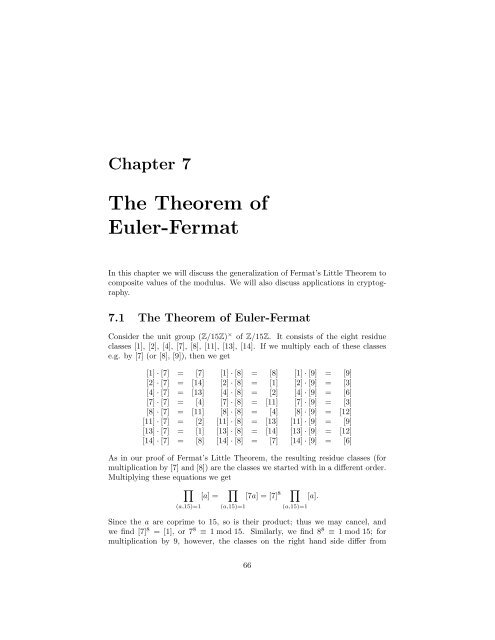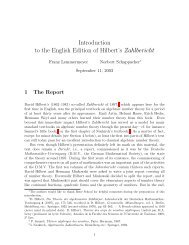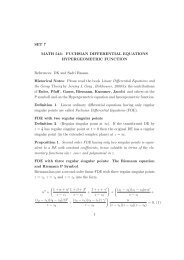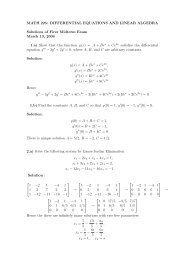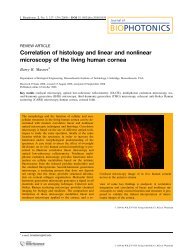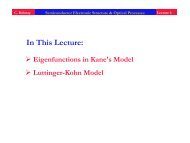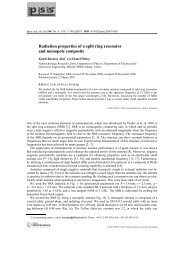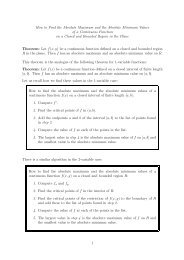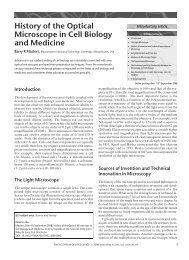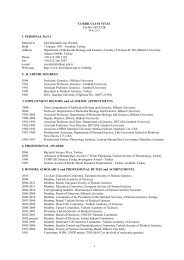You also want an ePaper? Increase the reach of your titles
YUMPU automatically turns print PDFs into web optimized ePapers that Google loves.
Chapter 7<br />
<strong>The</strong> <strong>The</strong>orem <strong>of</strong><br />
<strong>Euler</strong>-<strong>Fermat</strong><br />
In this chapter we will discuss the generalization <strong>of</strong> <strong>Fermat</strong>’s Little <strong>The</strong>orem to<br />
composite values <strong>of</strong> the modulus. We will also discuss applications in cryptography.<br />
7.1 <strong>The</strong> <strong>The</strong>orem <strong>of</strong> <strong>Euler</strong>-<strong>Fermat</strong><br />
Consider the unit group (Z/15Z) × <strong>of</strong> Z/15Z. It consists <strong>of</strong> the eight residue<br />
classes [1], [2], [4], [7], [8], [11], [13], [14]. If we multiply each <strong>of</strong> these classes<br />
e.g. by [7] (or [8], [9]), then we get<br />
[1] · [7] = [7] [1] · [8] = [8] [1] · [9] = [9]<br />
[2] · [7] = [14] [2] · [8] = [1] [2] · [9] = [3]<br />
[4] · [7] = [13] [4] · [8] = [2] [4] · [9] = [6]<br />
[7] · [7] = [4] [7] · [8] = [11] [7] · [9] = [3]<br />
[8] · [7] = [11] [8] · [8] = [4] [8] · [9] = [12]<br />
[11] · [7] = [2] [11] · [8] = [13] [11] · [9] = [9]<br />
[13] · [7] = [1] [13] · [8] = [14] [13] · [9] = [12]<br />
[14] · [7] = [8] [14] · [8] = [7] [14] · [9] = [6]<br />
As in our pro<strong>of</strong> <strong>of</strong> <strong>Fermat</strong>’s Little <strong>The</strong>orem, the resulting residue classes (for<br />
multiplication by [7] and [8]) are the classes we started with in a different order.<br />
Multiplying these equations we get<br />
∏<br />
[a] =<br />
∏<br />
∏<br />
[7a] = [7] 8 [a].<br />
(a,15)=1<br />
(a,15)=1<br />
(a,15)=1<br />
Since the a are coprime to 15, so is their product; thus we may cancel, and<br />
we find [7] 8 = [1], or 7 8 ≡ 1 mod 15. Similarly, we find 8 8 ≡ 1 mod 15; for<br />
multiplication by 9, however, the classes on the right hand side differ from<br />
66
those on the left (they’re all divisible by 3 since both 9 and 15 are), and we do<br />
not get 9 8 ≡ 1 mod 15.<br />
<strong>The</strong> same idea works in general. Let m ≥ 2 be an integer, and let φ(m)<br />
denote the number <strong>of</strong> residue classes coprime to m, that is, ϕ(m) = #(Z/mZ) × .<br />
<strong>The</strong>n we have the following result, which is usually referred to as the <strong>Euler</strong>-<br />
<strong>Fermat</strong> <strong>The</strong>orem: it is due to <strong>Euler</strong>, but contains <strong>Fermat</strong>’s Little <strong>The</strong>orem as a<br />
special case.<br />
<strong>The</strong>orem 7.1. If a is an integer coprime to m ≥ 2, then a ϕ(m) ≡ 1 mod m.<br />
For m = p prime, we have φ(p) = p − 1, and <strong>Euler</strong>’s <strong>The</strong>orem becomes<br />
<strong>Fermat</strong>’s Little <strong>The</strong>orem.<br />
Pro<strong>of</strong>. Let [r i ], i = 1, . . . , t = φ(m), denote the residue classes in (Z/mZ) × .<br />
<strong>The</strong>n we claim that [ar 1 ], . . . , [ar t ] are pairwise distinct. In fact, assume that<br />
[ar i ] = [ar j ] with i ≠ j, that is, ar i ≡ ar j mod m. Since gcd(a, m) = 1, we may<br />
cancel a, and get [r i ] = [r j ]: contradiction.<br />
Since the classes [ar 1 ], . . . , [ar t ] are all in (Z/mZ) × and different, and<br />
since there are only t different classes in (Z/mZ) × , we must have (Z/mZ) × =<br />
{[ar 1 ], . . . , [ar t ]}. But then ∏ t<br />
i=1 [r i] = ∏ t<br />
i=1 [ar i] = [a] φ(m) ∏ t<br />
i=1 [r i]. Since the<br />
[r i ] are coprime to m, so is their product. Cancelling then gives [a] φ(m) = [1],<br />
which proves the claim.<br />
7.2 <strong>Euler</strong>’s Phi Function<br />
For the application <strong>of</strong> <strong>Euler</strong>-<strong>Fermat</strong> we need a formula that allows us to compute<br />
φ(n). Let us first compute φ(n) directly for some small n. For n = 6, there are 6<br />
different residue classes modulo 6; the classes [0], [2], [3] and [4] are not coprime<br />
to 6 (or, in other words, do not have a multiplicative inverse), which leaves the<br />
classes [1] and 5 as the only ones that are coprime to 6: thus φ(6) = 2. <strong>The</strong><br />
classes mod 8 coprime to 8 are [1], [3], [5], [7], hence φ(8) = 4. If p is prime,<br />
then all the p−1 classes [1], [2], . . . , [p−1] are coprime to p, hence φ(p) = p−1.<br />
n 3 4 5 6 7 8 9 10 12 15<br />
φ(n) 2 2 4 2 6 4 6 4 4 8<br />
We can easily compute φ(p k ) (<strong>Euler</strong>’s phi function for prime powers): starting<br />
with all the nonzero classes [1], [2], . . . , [p 2 − 1] (there are p 2 − 1 <strong>of</strong> them)<br />
we have to eliminate those that are not coprime to p 2 , that is, exactly the<br />
multiples <strong>of</strong> p smaller than p 2 : these are p, 2p, 3p, . . . , (p − 1)p (note that<br />
p · p = p 2 > p 2 − 1); since there are exactly p − 1 <strong>of</strong> these multiples <strong>of</strong> p,<br />
there will be exactly p 2 − 1 − (p − 1) = p 2 − p = p(p − 1) classes left: thus<br />
φ(p 2 ) = p(p − 1).<br />
<strong>The</strong> same method works for p k : there are exactly p k − 1 nonzero classes,<br />
namely [1], [2], . . . , [p k − 1]. <strong>The</strong> multiples <strong>of</strong> p among these classes are [p],<br />
[2p], . . . , p k − p = (p k−1 − 1)p, and there are exactly p k−1 − 1 <strong>of</strong> them. Thus<br />
φ(p k ) = p k − 1 − (p k−1 − 1) = p k − p k−1 = p k−1 (p − 1).<br />
67
We have proved<br />
Proposition 7.2. For primes p and integers k ≥ 1, we have<br />
φ(p k ) = p k−1 (p − 1).<br />
Let us now compute φ(pq) for a product <strong>of</strong> two different primes. We have<br />
pq − 1 nonzero residue classes [1], [2], . . . , [pq − 1]. <strong>The</strong> classes that have a<br />
factor in common with pq are multiples <strong>of</strong> p and multiples <strong>of</strong> q, namely [p], [2p],<br />
. . . , [(q − 1)p and [q], [2q], . . . , [(p − 1)q]. Since there are no multiples <strong>of</strong> p<br />
that are multiples <strong>of</strong> q (like [0], [pq], etc) among these, there will be exactly<br />
pq − 1 − (p − 1) − (q − 1) = pq − p − q + 1 = (p − 1)(q − 1) classes left after<br />
eliminating multiples <strong>of</strong> p or q. Thus φ(pq) = (p − 1)(q − 1) = φ(p)φ(q).<br />
<strong>The</strong> general result is<br />
Proposition 7.3. If m and n are coprime integers, then φ(mn) = φ(m)φ(n).<br />
Before we turn to the pro<strong>of</strong>, let’s see how it works in a specific example like<br />
m = 5 and n = 3. What we’ll do is take a residue class modulo 15 and coprime<br />
to 15, and map it to a pair <strong>of</strong> residue classes mod 3 and mod 5:<br />
a mod 15 1 2 4 7 8 11 13 14<br />
a mod 3 1 2 1 1 2 2 1 2<br />
a mod 5 1 2 4 2 3 1 3 4<br />
Thus we have the following pairs <strong>of</strong> residue classes modulo 3 and 5: (1, 1), (1, 2),<br />
(1, 3), (1, 4) and (2, 1), (2, 2), (2, 3), (2, 4). In particular, there are φ(5) = 4 pairs<br />
with a ≡ 1 mod 3 and 4 pairs with a ≡ 2 mod 3.<br />
Pro<strong>of</strong> <strong>of</strong> Prop. 7.3. We have to find a map sending a residue class modulo mn<br />
to two residue classes modulo m and n. Let’s try<br />
ψ : (Z/mnZ) × −→ (Z/mZ) × × (Z/nZ) × : [a] mn ↦−→ ([a] m , [a] n ).<br />
All that’s left to do is check that it works. First observe that gcd(ab, n) = 1 if<br />
and only if gcd(a, n) = gcd(b, n) = 1.<br />
Surjectivity: We have to show that, given residue classes [r] m and [s] n , there<br />
exists a residue class [a] mn such that [a] m = [r] m and [a] n = [s] n . At this point,<br />
Bezout comes in again: since gcd(m, n) = 1, there exist x, y ∈ Z such that<br />
1 = mx + ny. Now put a = ryn + sxm: then a = ryn + sxm ≡ ryn ≡<br />
1 mod m since yn ≡ 1 mod m from the Bezout representation, and similarly<br />
a = ryn + sxm ≡ sxm ≡ s mod n.<br />
Injectivity: Assume that there are residue classes [a] mn and [b] mn such that<br />
[a] m = [b] m and [a] n = [b] n . <strong>The</strong>n m | (b − a) and n | (b − a), and since<br />
gcd(m, n) = 1, this implies that [a] mn = [b] mn and proves the injectivity <strong>of</strong><br />
φ.<br />
Here is how one could come up with the application <strong>of</strong> Bezout in the above<br />
pro<strong>of</strong>. Given coprime residue classes r mod m and s mod m, we want a formula<br />
68
for computing an integer a such that a ≡ r mod m and a ≡ s mod n. <strong>The</strong> first<br />
idea is to see whether a can be written as a linear combination <strong>of</strong> r and s, that<br />
is, to look for integers x, y such that a = xr + ys. Reduction modulo m gives<br />
r ≡ a = xr + ys mod m. (7.1)<br />
<strong>The</strong> simplest way to achieve this is by taking x = 1 and y = 0. But observe<br />
that we also need<br />
s ≡ a ≡ xr + ys mod n. (7.2)<br />
Thus we need more leeway. <strong>The</strong> right idea is to observe that (7.1) will be<br />
satisfied if only x ≡ 1 mod m, y ≡ 0 mod m. Similarly, (7.2) will be satisfied if<br />
x ≡ 0 mod n and y ≡ 1 mod n.<br />
Is it possible to satisfy these four congruences simultaneously? Let’s see:<br />
x ≡ 0 mod n and y ≡ 0 mod m mean x = an and y = bm for some a, b ∈ Z. <strong>The</strong><br />
two other congruences boil down to x = an ≡ 1 mod m and y = bm ≡ 1 mod n.<br />
But these are both solvable since gcd(m, n) = 1, so n has an inverse a modulo<br />
m, and m has an inverse b modulo n. Inverses can be computed using Bezout,<br />
and collecting everything we now can see where the formulas in the above pro<strong>of</strong><br />
were coming from.<br />
Combining the formulas for <strong>Euler</strong>’s phi function for prime powers and for<br />
products <strong>of</strong> coprime integers, we now find that an integer<br />
has exactly<br />
residue classes coprime to m.<br />
m = p a1<br />
1 · · · par r<br />
Chinese Remainder <strong>The</strong>orem<br />
φ(m) = (p 1 − 1)p a1−1<br />
1 · · · (p r − 1)pr<br />
ar−1<br />
= p a1<br />
1 · · · par r · p1 − 1<br />
· · · pr − 1<br />
p 1 p r<br />
= m<br />
(1 − 1 )<br />
· · ·<br />
(1 − 1 )<br />
p 1 p r<br />
In the pro<strong>of</strong> <strong>of</strong> the multiplicativity <strong>of</strong> <strong>Euler</strong>’s phi function we have shown that,<br />
given a system <strong>of</strong> congruences<br />
x ≡ a mod m<br />
y ≡ b mod n<br />
can always be solved if m and n are coprime. This result, or rather its generalization<br />
to system <strong>of</strong> arbitrarily many such congruences, is called the Chinese<br />
Remainder <strong>The</strong>orem.<br />
69
<strong>The</strong> Abstract Version<br />
<strong>The</strong>re is more to the bijection<br />
ψ : (Z/mnZ) × −→ (Z/mZ) × × (Z/nZ) × : [a] mn ↦−→ ([a] m , [a] n )<br />
constructed above than meets the eye: we claim that ψ induces an isomorphism<br />
(Z/mnZ) × −→ (Z/mZ) × × (Z/nZ) × .<br />
A homomorphism between groups (G, ◦) and (H, ∗) is a map f : G −→ H<br />
that respects the group laws in the sense that we have f(g ◦ g ′ ) = f(g) ∗ f(g ′ ).<br />
Here are some examples:<br />
1. the exponential function is a homomorphism exp : (R, +) −→ (R >0 , ·)<br />
because exp(a + b) = exp(a) exp(b).<br />
2. the logarithm is a homomorphism log : (R >0 , ·) −→ (R, +) because log ab =<br />
log a + log b. Note that exp and log are inverse maps <strong>of</strong> each other.<br />
3. <strong>The</strong> set C ∞ <strong>of</strong> all infinitely <strong>of</strong>ten differentiable functions (0, 1) −→ R is<br />
an additive group, and d dx<br />
: C∞ −→ C ∞ is a homomorphism because<br />
(f + g) ′ = f ′ + g ′ .<br />
4. If f : V −→ W is a linear map between K-vector spaces V and W , then f<br />
is also a homomorphism between the additive groups (V, +) and (W, +).<br />
5. <strong>The</strong> map ψ : (Z/mnZ) × −→ (Z/mZ) × × (Z/nZ) × is a homomorphism.<br />
In fact we have<br />
ψ([ab] mn ) = ([ab] m , [ab]n),<br />
ψ([a] mn ) = ([a] m , [a]n),<br />
ψ([b] mn ) = ([b] m , [b]n),<br />
and by the group law in direct products we see that<br />
ψ([ab] mn ) = ψ([a] mn )ψ([b] mn ).<br />
If (G, ◦) and (H, ∗) are groups, then the cartesian product G×H can be given a<br />
group structure by defining (g, h)(g ′ , h ′ ) = (g ◦ g ′ , h ◦ h ′ ). Checking the axioms<br />
is straightforward. Also, if G × H is abelian if and only if G and H are.<br />
Observe that if f : G −→ H is a homomorphism between additively written<br />
groups, then f(0) = 0 and f(−g) = −f(g). This follows easily from the axioms.<br />
Since we have already seen that ψ is bijective, we can conclude that it is an<br />
isomorphism. Note that for any bijective homomorphism f : G −→ H there<br />
exists a homomorphism g : H −→ G such that f ◦ g and g ◦ f are the identity<br />
maps on H and G, respectively.<br />
We can play this game also with rings: a map from a ring R to some ring S is<br />
called a ring homomorphism if f(r + r ′ ) = f(r) + f(r ′ ), f(rr ′ ) = f(r)f(r ′ ), and<br />
f(1) = 1. It is then easy to show that ψ actually induces a ring isomorphism<br />
Z/mnZ −→ Z/mZ × Z/nZ: this is the abstract formulation <strong>of</strong> the Chinese<br />
Remainder <strong>The</strong>orem.<br />
70
7.3 <strong>The</strong> Order <strong>of</strong> Residue Classes<br />
Assume that we are given an integer m and an integer a coprime to m. <strong>The</strong><br />
smallest exponent n > 0 such that a n ≡ 1 mod m is called the order <strong>of</strong> a mod m;<br />
we write n = ord m (a). Note that we always have ord m (1) = 1. Here’s a table<br />
for the orders <strong>of</strong> elements in (Z/7Z) × :<br />
a mod 7 1 2 3 4 5 6<br />
ord 7 (a) 1 3 6 3 6 2<br />
If m = p is prime, then <strong>Fermat</strong>’s Little <strong>The</strong>orem gives us a p−1 ≡ 1 mod p,<br />
i.e., the order <strong>of</strong> a mod p is at most p − 1. In general, the order <strong>of</strong> a is not p − 1;<br />
it is, however, always a divisor <strong>of</strong> p − 1 (as the table above suggested):<br />
Proposition 7.4. Given a prime p and an integer a coprime to p, let n denote<br />
the order <strong>of</strong> a modulo p. If m is any integer such that a m ≡ 1 mod p, then<br />
n | m. In particular, n divides p − 1.<br />
Pro<strong>of</strong>. Write d = gcd(n, m) and d = nx + my; then a d = a nx+my ≡ 1 mod p<br />
since a n ≡ a m ≡ 1 mod p. <strong>The</strong> minimality <strong>of</strong> n implies that n ≤ d, but then<br />
d | n shows that we must have d = n, hence n | m.<br />
Here comes a pretty application to prime divisors <strong>of</strong> Mersenne and <strong>Fermat</strong><br />
numbers.<br />
Corollary 7.5. If p is an odd prime and if q | M p , then q ≡ 1 mod 2p.<br />
Pro<strong>of</strong>. It suffices to prove this for prime values <strong>of</strong> q (why?). So assume that<br />
q | 2 p − 1; then 2 p ≡ 1 mod q. By Proposition 7.4, the order <strong>of</strong> 2 mod p divides<br />
p, and since p is prime, we find that p = ord p (a).<br />
On the other hand, we also have 2 q−1 ≡ 1 mod p by <strong>Fermat</strong>’s little theorem,<br />
so Proposition 7.4 gives p | (q − 1), and this proves the claim because we clearly<br />
have q ≡ 1 mod 2.<br />
Example: M 11 = 2047 = 23 · 89.<br />
<strong>Fermat</strong> numbers are integers F n = 2 2n + 1 (thus F 1 = 5, F 2 = 17, F 3 = 257,<br />
F 4 = 65537, . . . ), and <strong>Fermat</strong> conjectured (and once even seemed to claim he<br />
had a pro<strong>of</strong>) that these integers are all primes. <strong>The</strong>se integers became much<br />
more interesting when Gauss succeeded in proving that a regular p-gon, p an<br />
odd prime, can be constructed with ruler and compass if p is a <strong>Fermat</strong> prime.<br />
Gauss also stated that he had proved the converse, namely that if a regular<br />
p-gon can be constructed by ruler and compass, then p is a <strong>Fermat</strong> prime, but<br />
the first (almost) complete pro<strong>of</strong> was given by Pièrre Wantzel. 1<br />
Corollary 7.6. If q divides F n , then q ≡ 1 mod 2 n+1 .<br />
1 Pièrre Wantzel, 1814 (Paris) – 1848 (Paris).<br />
71
Pro<strong>of</strong>. It is sufficient to prove this for prime divisors q. Assume that q | F n ; then<br />
2 2n + 1 ≡ 1 mod q, hence 2 2n ≡ −1 mod q and 2 2n+1 ≡ 1 mod q. We claim that<br />
actually 2 n+1 = ord q (2): in fact, Proposition 7.4 says that the order divides<br />
2 n+1 , hence is a power <strong>of</strong> 2. But 2 n+1 is clearly the smallest power <strong>of</strong> 2 that<br />
does it.<br />
On the other hand, 2 q−1 ≡ 1 mod q by <strong>Fermat</strong>’s Little <strong>The</strong>orem, and Proposition<br />
7.4 gives 2 n+1 | (q − 1), which proves the claim.<br />
In particular, the possible prime divisors <strong>of</strong> F 5 = 4294967297 are <strong>of</strong> the<br />
form q = 64m + 1. After a few trial divisions one finds F 5 = 641 · 6700417.<br />
This is how <strong>Euler</strong> disproved <strong>Fermat</strong>’s conjecture. Today we know the prime<br />
factorization <strong>of</strong> F n for all n ≤ 11, we know that F n is composite for 5 ≤ n ≤ 30<br />
(and several larger values up to n = 382447), and we don’t know any factors for<br />
n = 14, 20, 22 and 24. See<br />
http://www.prothsearch.net/fermat.html<br />
for more.<br />
7.4 RSA<br />
Cryptography deals with methods that allow us to transmit information safely,<br />
that is, in such a way that eavesdroppers have no chance <strong>of</strong> reading it. Simple<br />
methods for encrypting messages were known and widely used in military circles<br />
for several millenia; basically all <strong>of</strong> these codes are easy to break with computers.<br />
An example <strong>of</strong> such a classical code is Caesar’s cipher: permute the letters<br />
<strong>of</strong> the alphabet by sending X ↦−→ A, Y ↦−→ B, Z ↦−→ C, A ↦−→ D etc; the text<br />
“ET TU, BRUTE” would be encrypted as “BQ QR, YORQB”. For longer texts,<br />
analyzing the frequency <strong>of</strong> letters (for given languages) makes breaking this and<br />
similar codes a breeze, in particular if you are equipped with a computer.<br />
Another common feature <strong>of</strong> these ancient methods <strong>of</strong> encrypting messages<br />
is the following: anyone who knows the key, that is, the method with which<br />
messages are encrypted, can easily break the code by inverting the encryption.<br />
In 1976, Diffie and Hellman suggested the existence <strong>of</strong> public key cryptography:<br />
these are methods for encrypting messages that do not allow you to read encrypted<br />
messages even if you know the key. <strong>The</strong> most famous <strong>of</strong> all public key<br />
cryptosystems is called RSA after its discoverers Ramir, Shamir and Adleman<br />
(1978).<br />
Here’s the simple idea: assume that Bob wants to receive secure messages;<br />
he selects two (large) primes p and q and forms their product n = pq. Bob also<br />
chooses an integer E < n coprime to (p − 1)(q − 1). <strong>The</strong> integers n and E are<br />
made public and constitute the key, so everybody can encrypt messages. For<br />
decrypting messages, however, one needs to know the prime factors p and q, and<br />
if p and q are large enough (say about 150 digits each) then known factorization<br />
methods cannot factor n in any reasonable amount <strong>of</strong> time (say 100 years).<br />
How does the encryption work? It is a simple matter to transform any text<br />
into a sequence <strong>of</strong> numbers, for example by using a ↦−→ 01, b → 02, . . . , with a<br />
72
couple <strong>of</strong> extra numbers for blanks, commas, etc. We may therefore assume that<br />
our message is a sequence <strong>of</strong> integers T < n (if the text is longer, break it up<br />
into smaller pieces). Alice encrypts each integer T as C ≡ T E mod n and sends<br />
the sequence <strong>of</strong> C’s to Bob (by email, say). Now Bob can decrypt the message<br />
as follows: since he knows p and q, he can form the product m = (p − 1)(q − 1)<br />
and run the Euclidean algorithm on the pair (E, m) to find an integer D such<br />
that DE ≡ 1 mod m. Now he takes the message C and computes C D mod n.<br />
<strong>The</strong> result is C D ≡ (T E ) D = T DE mod n, but since DE ≡ 1 mod m = φ(n),<br />
the theorem <strong>of</strong> <strong>Euler</strong>-<strong>Fermat</strong> shows that C D ≡ T mod n, and Bob has got the<br />
original text that Alice sent him.<br />
Now assume that Celia is eavesdropping. Of course she knows the pair (n, E)<br />
(which is public anyway), and she also knows the message C that Alice sent to<br />
Bob. That does not suffice for decrypting the message, however, since one seems<br />
to need an inverse D <strong>of</strong> E mod (p − 1)(q − 1) to do that; it is likely that one<br />
needs to know the factors <strong>of</strong> n in order to compute D.<br />
Baby Example. <strong>The</strong> following choice <strong>of</strong> n = 1073 with p = 29 and q = 37 is<br />
not realistic because this number can be factored easily; its only purpose is to<br />
illustrate the method.<br />
So assume that Bob picks the key (n, E) = (1073, 25). Alice wants to send<br />
the message ”miss piggy” to Bob. She starts by transforming the message into<br />
a string <strong>of</strong> integers as follows:<br />
m i s s p i g g y<br />
T 13 9 19 19 27 16 9 7 7 25<br />
Next she encrypts this sequence by computing C ≡ T 25 mod n for each <strong>of</strong><br />
these T : starting with 13 25 ≡ 671 mod 1073, she finds<br />
T 13 9 19 19 27 16 9 7 7 25<br />
C 671 312 901 901 656 1011 312 922 922 546<br />
Alice sends this string <strong>of</strong> C’s to Bob. Knowing the prime factorization <strong>of</strong><br />
n, Bob is able to compute the inverse <strong>of</strong> 25 mod (p − 1)(q − 1) as follows: he<br />
multiplies p − 1 = 28 and q − 1 = 36 to get (p − 1)(q − 1) = 28 · 36 = 1008.<br />
<strong>The</strong>n he applies the extended Euclidean algorithm to (25, 1008) and finds 1 =<br />
25 · 121 − 1008 · 3, and this shows that D = 121.<br />
Now Bob takes the string <strong>of</strong> C’s he got from Alice and decrypts them: starting<br />
with 671 121 ≡ 13 mod n he can get back the string <strong>of</strong> T’s, and hence the<br />
original message.<br />
Remark. <strong>The</strong>re is a big problem with this baby example: if we encrypt the<br />
message letter for letter, then equal letters will have equal code, and the cryptosystem<br />
can be broken (if the message is long enough) by analyzing the frequency<br />
with which each letter occurs (say in English). This problem vanishes<br />
into thin air when we use (realistic) key sizes <strong>of</strong> about 200 digits: there we encrypt<br />
the message in blocks <strong>of</strong> about 100 letters, and since the chance that any<br />
two blocks <strong>of</strong> 100 letters inside a message coincide is practically 0, an attack<br />
based on the frequency <strong>of</strong> letters will not be successful for keys <strong>of</strong> this size.<br />
73
RSA can also be applied to the signature problem. Assume that Alice receives<br />
an email from someone claiming to be Bob. How can Alice verify that this<br />
is true? Here’s the simple trick in a nutshell: both Bob and Alice choose public<br />
keys, say (n A , E A ) for Alice and (n B , E B ) for Bob. Moreover, Alice knows D A<br />
with D A E A ≡ 1 mod φ(n A ), while Bob knows D B with D B E B ≡ 1 mod φ(n B ).<br />
Now Bob encrypts his message as above, but instead <strong>of</strong> sending the T’s to Alice,<br />
he computes U = T D B<br />
mod n B and sends the U’s. In order to decrypt the<br />
message, Alice computes first T ≡ U E D<br />
mod n B and then decrypts the T’s as<br />
in the original version <strong>of</strong> RSA using her D A . If this works, then Alice can be<br />
sure that the message came from Bob because in order to encrypt the message<br />
this way, the sender has to know D B .<br />
7.5 Pollard’s p − 1-Factorization Method<br />
Pollard is definitely the world champion in inventing new methods for factoring<br />
integers. One <strong>of</strong> his earliest contributions were the p − 1-method (ca. 1974),<br />
his ρ-method followed shortly after, and his latest invention is the number field<br />
sieve (which is based on ideas from algebraic number theory).<br />
<strong>The</strong> idea behind Pollard’s p − 1-method is incredibly simple. Assume that<br />
we are given an integer N that we want to factor. Fix an integer a > 1 and<br />
check that gcd(a, N) = 1 (should d = gcd(a, N) be not trivial, then we have<br />
already found a factor d and continue with N replaced by N/d).<br />
Let p be a factor <strong>of</strong> N; by <strong>Fermat</strong>’s Little <strong>The</strong>orem we know that a p−1 ≡<br />
1 mod p, hence D := gcd(a p−1 − 1, N) has the properties p | D and D | N.<br />
Thus D is a nontrivial factor <strong>of</strong> N unless D = N (which should not happen too<br />
<strong>of</strong>ten).<br />
<strong>The</strong> procedure above is not much <strong>of</strong> a factorization algorithm as long as we<br />
have to know the prime factor p beforehand. <strong>The</strong> prime p occurs at two places in<br />
the method above: first, as the modulus when computing a p−1 mod p. But this<br />
problem is easily taken care <strong>of</strong> because we may simply compute a p−1 mod N. It<br />
is more difficult to get rid <strong>of</strong> the p in the exponent: the fundamental observation<br />
is that we can replace the exponent p − 1 above by any multiple, and D still<br />
will be divisible by p (note though that the chance that D = N has become<br />
slightly larger). Does this help us? Not always; assume, however, that p − 1 is<br />
the product <strong>of</strong> small primes (say <strong>of</strong> primes below a bound B that in practice<br />
can be taken to be B = 10 5 or B = 10 6 , depending on the computing power <strong>of</strong><br />
your hardware). <strong>The</strong>n it is not too hard to come up with good candidates for<br />
multiples <strong>of</strong> p − 1: we might simply pick k = B!, or, in a similar vein,<br />
k = ∏ i<br />
p ai<br />
i ,<br />
where pai i ≤ B < p ai+1<br />
i . (7.3)<br />
If we (p − 1) | k, then a k ≡ 1 mod p, hence p | D = gcd(a k − 1, N).<br />
Thus the following algorithm has a good chance <strong>of</strong> finding those factors p <strong>of</strong><br />
N for which p − 1 has only small prime factors:<br />
74
1. Pick a > 1 and check that gcd(a, N) = 1<br />
2. Choose a bound B, say B = 10 4 , 10 5 , 10 6 , ...<br />
3. Pick k as in (7.3) and compute D = gcd(a k − 1, N).<br />
Note that the computation <strong>of</strong> a k can be done modulo N; if p | N and<br />
(p − 1) | k, then a k ≡ 1 mod p, hence p | D.<br />
If D = 1, we may increase k; if D = N, we can reduce k and repeat the<br />
computation.<br />
Among the record factors found by the p − 1-method is the 37-digit factor<br />
p = 6902861817667290192729108442204980121 <strong>of</strong> 71 77 − 1 with p − 1 = 2 3 · 3 3 ·<br />
5·7·11·13·401·409·3167·83243·83983·800221·2197387 discovered by Dubner.<br />
A list <strong>of</strong> record factors can be found at<br />
http://www.users.globalnet.co.uk/ ∼ aads/Pminus1.html<br />
Here’s a baby example: take N = 1769, a = 2 and B = 6. <strong>The</strong>n we compute<br />
k = 2 2·3·5 and we find 2 60 ≡ 306 mod 1769, gcd(305, 1769) = 61 and N = 29·61.<br />
Note that 61 − 1 = 2 2 · 3 · 5, so the factor 61 was found, while 29 − 1 = 2 2 · 7<br />
explains why 29 wasn’t (although 29 < 61).<br />
Another large class <strong>of</strong> factorization algorithms is based on an algorithm<br />
invented by <strong>Fermat</strong>: the idea is to write an integer n as a difference <strong>of</strong> squares.<br />
If n = x 2 −y 2 , then n = (x−y)(x+y), and unless this is the trivial factorization<br />
n = 1 · n, we have found a factor.<br />
Another baby example: take n = 1073; then √ n = 32.756 . . ., so we start by<br />
trying to write n = 33 2 − y 2 . Since 33 2 − 1073 = 16, we find n = 33 2 − 4 2 =<br />
(33 − 4)(33 + 4) = 29 · 37. If the first attempt would have been unsuccessful, we<br />
would have tried n = 34 2 − y 2 , etc.<br />
In modern algorithms (continued fractions, quadratic sieve, number field<br />
sieve) the equation N = x 2 − y 2 is replaced by a congruence x 2 ≡ y 2 mod N: if<br />
we have such a thing, then gcd(x−y, N) has a good chance <strong>of</strong> being a nontrivial<br />
factor <strong>of</strong> N. <strong>The</strong> first algorithm above constructed such pairs (x, y) by computing<br />
the continued fraction expansion <strong>of</strong> √ n (which we have not discussed), the<br />
number field sieve produces such pairs by factoring certain elements in algebraic<br />
number fields.<br />
Exercises<br />
7.1 Compute the addition and multiplication tables for the ring Z/2Z ⊕ Z/2Z, and<br />
compare the result to those for Z/4Z.<br />
7.2 Do the same exercise for the rings Z/2Z ⊕ Z/3Z and Z/6Z.<br />
7.3 Find all integers with φ(m) = 6.<br />
7.4 Show that m is prime if and only if φ(m) = m − 1.<br />
75
7.5 Solve the system <strong>of</strong> congruences<br />
x ≡ 12 mod 13,<br />
x ≡ 7 mod 19.<br />
76


